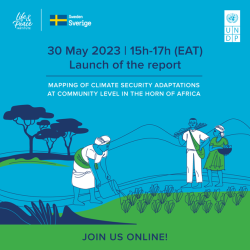Publications & reports
MAPPING OF CLIMATE SECURITY ADAPTATIONS AT COMMUNITY LEVEL IN THE HORN OF AFRICA
This study explores how communities experience climate change and develop coping mechanisms. It looks at possible climate security solutions and shows how all actors must work together to address these threats, as no single community has the answer.

- Date
- Type
- Publication
- Country/Region
- Horn of Africa
Summary
The pathways through which climate and conflict factors are manifested, are determined by the local interplay of exposure to climatic hazards, vulnerability, and the coping capacity of states and communities. As climate change increasingly impacts the Horn of Africa, it is critical to identify and mitigate climate security risks at sub-regional, national, and local levels. This requires improved knowledge of potentially impactful adaptations that are showing positive results. The goal of this assignment was to fill a current gap in identifying interdisciplinary programmatic solutions at the local level that are already addressing the interlinked nature of climate, peace, and security in the various parts of the Horn of Africa. The study had twin aims: firstly, to identify how communities are experiencing climate change. Secondly, where possible, to identify and map integrated community level climate security solutions to these risks. Given the community level focus, the study focused on the human security implications of various climate security threats and their responses to address the risks.